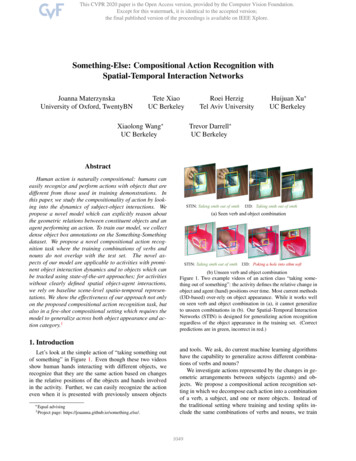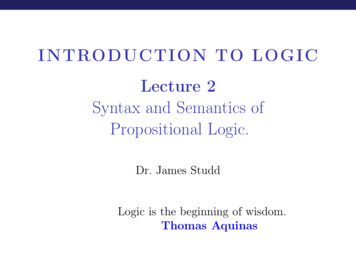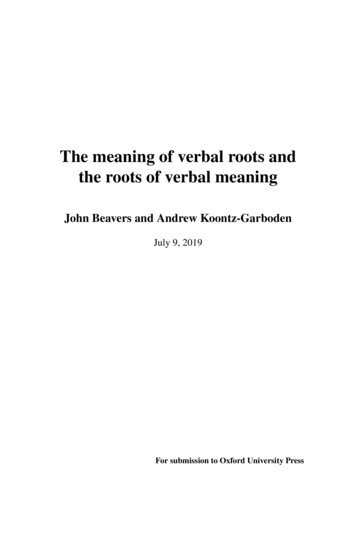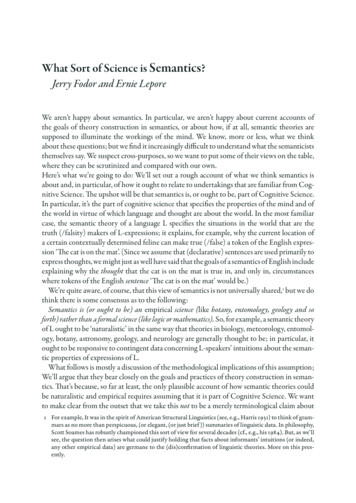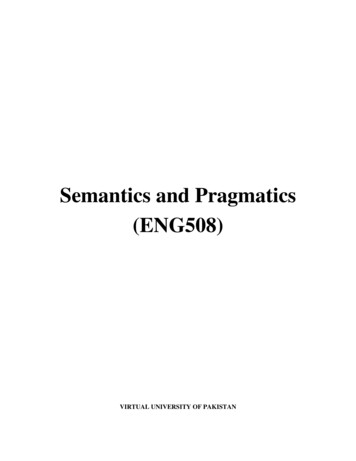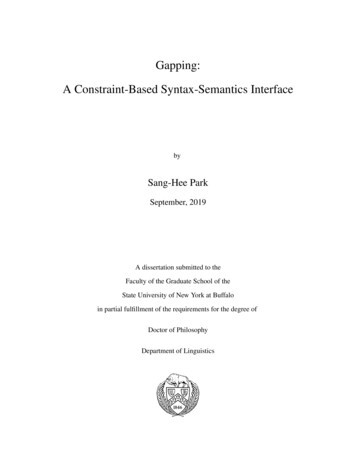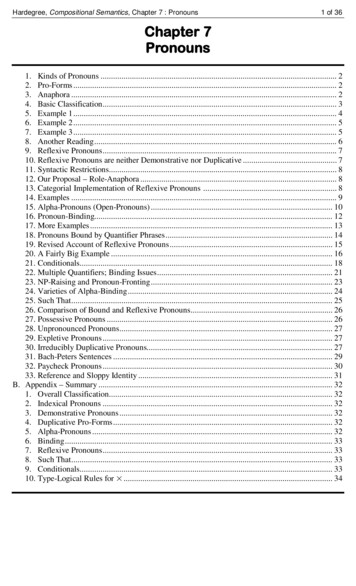
Transcription
Hardegree, Compositional Semantics, Chapter 7 : Pronouns1 of 36Chapter 7Pronouns1. Kinds of Pronouns . 22. Pro-Forms . 23. Anaphora . 24. Basic Classification. 35. Example 1 . 46. Example 2 . 57. Example 3 . 58. Another Reading . 69. Reflexive Pronouns . 710. Reflexive Pronouns are neither Demonstrative nor Duplicative . 711. Syntactic Restrictions. 812. Our Proposal – Role-Anaphora . 813. Categorial Implementation of Reflexive Pronouns . 814. Examples . 915. Alpha-Pronouns (Open-Pronouns) . 1016. Pronoun-Binding. 1217. More Examples . 1318. Pronouns Bound by Quantifier Phrases . 1419. Revised Account of Reflexive Pronouns . 1520. A Fairly Big Example . 1621. Conditionals. 1822. Multiple Quantifiers; Binding Issues . 2123. NP-Raising and Pronoun-Fronting . 2324. Varieties of Alpha-Binding . 2425. Such That . 2526. Comparison of Bound and Reflexive Pronouns. 2627. Possessive Pronouns . 2628. Unpronounced Pronouns. 2729. Expletive Pronouns . 2730. Irreducibly Duplicative Pronouns. 2731. Bach-Peters Sentences . 2932. Paycheck Pronouns . 3033. Reference and Sloppy Identity . 31B. Appendix – Summary . 321. Overall Classification. 322. Indexical Pronouns . 323. Demonstrative Pronouns . 324. Duplicative Pro-Forms . 325. Alpha-Pronouns . 326. Binding . 337. Reflexive Pronouns . 338. Such That . 339. Conditionals. 3310. Type-Logical Rules for . 34
Hardegree, Compositional Semantics, Chapter 7 : Pronouns1.2 of 36Kinds of PronounsIn traditional grammar and lexicography, the term ‘pronoun’ applies to a wide variety of Englishwords, including the following.personal pronounsI, you, he, she, it, we, theyme, him, her, us, themmy, your, his, her, its, our, theirmine, yours, his, hers, ours, theirsmyself, yourself, himself, herself, itself,ourselves, themselvesdemonstrative pronounsthis, that, these, thoseinterrogative pronounswho, whom, whose, which, why, when,where, howrelative pronounswho, whom, whose, which, why, how, thatwhoever, whatever, whenever, wherever,howeverexpletive pronounsit, thereIn this chapter, we concentrate on personal pronouns.2.Pro-FormsPersonal pronouns are a special case of the more general syntactic class called pro-forms, whichinclude the following.pro-NPJay respects his mother.pro-VPJay respects Kay, and so does Elle.pro-adjectiveno such person lives here.pro-common-nounthis dog is large, but that one is small.pro-sentenceJay may visit tomorrow, in which caseKay will meet him at the train station.In principle, but not in practice, for each category K, there is an associated category of pro-Ks. Noticealso that personal pronouns are pro-NPs, where NP is a multi-typed category that includes propernouns, determiner phrases, and relative pronouns.3.AnaphoraPro-forms are intimately connected to anaphora,1 which are phrases that are semanticallydependent upon other (usually earlier) phrases in the surrounding discourse unit. In addition to proforms, anaphoric items include the following examples.if it is sunny, I will play tennis; otherwise, I will play racket ballJay and Kay played tennis yesterday, but no one else didKay hosted a party last Friday; Jay got drunk 2The last one has no phonetically-overt anaphoric material; rather, the implicit place-time-reference ofthe second clause is dependent upon the place-time-reference of the antecedent clause.Not all pronouns are anaphoric, however, as we see in the next section.1The term ‘anaphora’ is also used in Rhetoric to refer to a rhetorical device by which a phrase is repeated severaltimes. Many famous lines, in fiction and real-life, employ this device, including examples from Dickens [“they werethe best of times, ”], Churchill [“we will fight them on the beaches, ”], and Martin Luther King [“I have adream ”].2Adapted from Partee (1984).
Hardegree, Compositional Semantics, Chapter 7 : Pronouns4.3 of 36Basic ClassificationHenceforth, in this chapter, by ‘pronoun’ we usually mean personal pronoun. Pronouns may bethought of as pointers. A pronoun can point externally, in which case one might call it exophoric. Apronoun can also point internally, in which case it one might call it endophoric. Other termscommonly used are deictic3 and anaphoric. 4 In the latter case, the phrase to which the pronoun pointsis called its antecedent, and the pronoun is said to be anaphoric to its antecedent.Exophoric pronouns and endophoric pronouns can be further classified as follows.1.Exophoric Pronouns [point externally]1.Indexical PronounsIndexical expressions point at inherent features of the utterance-context, which includeplace, time, speaker, and addressee. and include words such as: 5I, you, here, nowThe following is an example diagram.I respectspeaker2.you addresseeDemonstrative Pronouns6Sometimes the utterance-context includes acts of demonstration (pointing, showing),which can be overt or tacit. Demonstrative pronouns can be used in this manner, as illustratedin the following diagrams.he respects1st demonstrateeI speaker2.selecther 2nd demonstrateeyou you 1st demonstratee 2nd demonstrateeandyou 3rd demonstrateeEndophoric Pronouns [point internally]1.Duplicative PronounsSuch a pronoun simply repeats the content of its antecedent.7Jay respects Kay but she does not respect him Kay JayThe term ‘deixis’ derives from Greek δεῖξις (display, exhibit, show, demonstrate).The word ‘anaphora’ comes from Greek (ἀναφορά), which means "carrying back". Related words include‘metaphor’ [carrying beyond], ‘semaphore’ [carrying sign], ‘phosphor’ [carrying light], and even ‘Bosporus’(‘Bosphorus’) [carrying cows]. To this list we add the technical terms ‘exophoric’ [carrying outside] and‘endophoric’ [carrying inside].5 Interestingly, in English, only ‘I’ is used exclusively as an indexical expression. The others are also useddemonstratively. The pronoun ‘we’ is partly indexical, since it semantically includes ‘I’, but it is partlydemonstrative, since it semantically includes other (demonstrated) individuals as well. Locative expressions like‘here’ and ‘now’ are often indexical, but need not be.6 The demonstrative use of personal pronouns is distinguished from what are often called demonstrative pronouns –‘this’, ‘that’, ‘these’, ‘those’.7 Sometimes, such pronouns are called lazy pronouns. Here, the idea is that a lazy-pronoun is used to say somethingthat could be said equally well without that pronoun. Note, however, that this sort of "laziness" is often a mark ofgood speech-pragmatics. Note also that the term ‘lazy pronoun’ may mean a pronoun that duplicates the wording ofits antecedent rather than the content of its antecedent. We insist that such a pronoun duplicates content.34
Hardegree, Compositional Semantics, Chapter 7 : Pronouns2.4 of 36Non-Duplicative PronounsSuch a pronoun does not simply repeat the content its antecedent. 8every man respectshis mother every man's5.Example 1We begin by examining demonstrative and duplicative pronouns, by considering the followingexample.1.Jay respects his motherThe semantic analysis depends upon answering two questions.(1)(2)is ‘he’ exophoric (demonstrative) or endophoric (anaphoric)?supposing ‘he’ is anaphoric, what is it anaphoric to?1.Demonstrative Reading of ‘he’In this case, ‘he’ denotes an entity in the domain that is demonstrated or otherwise salient, whichis formally supplied by the utterance-context (situation). We propose to use ‘δ’ to refer todemonstrated entities; if there is just one such entity, we use ‘δ’ by itself; if there are more thanone, then we use ‘δ1’, ‘δ2’, etc. The semantic-tree then looks thus.Jay 1J . 1respectshe'smotherδ . 6δ69 2 6:M( ) . 2M(δ) 2 1R M(δ)2 1R[ , M(δ)]J1R[J, M(δ)]2.Duplicative Reading of ‘he’In this case, ‘he’ simply duplicates the content of ‘Jay’, as seen in the following tree. Jay 1J . 1respects he'sJ . 6J6mother 6:M( )M(J) 2 1R J1 2 . 2M(J)2 1R[ , M(J)]R[J, M(J)]89Bound pronouns further subdivide into reflexive-pronouns and open-pronouns, which we discuss in later sections.In this chapter, we treat ‘mother’ and ‘father’ as definite, taking for granted the morpheme DEF.
Hardegree, Compositional Semantics, Chapter 7 : Pronouns5 of 36In order to indicate duplicative relations, we insert additional markers – circled-numerals – overthe relevant phrases. For example, in the above derivation, ‘Jay’ and ‘he’ are anaphoricallylinked, both being marked by . Note that the semantic entry for ‘he’ is identical to the entryfor ‘Jay’. This is the characteristic feature of a duplicative pro-form – it simply repeats thesemantic content of its antecedent, which is officially stated in the following global semanticrule.10The semantic-value of a duplicative pro-formis identical tothe semantic-value of its antecedent.6.Example 2Although we concentrate on pronouns, we find it useful to consider at least one other kind ofpro-form, namely pro-VP, which is exemplified in the following example.2.Jay respects Kay, and so does ElleWe propose to treat all pro-VPs as duplicative. For example, in the above example, ‘so does’duplicates the VP ‘respects Kay’, in which case this sentence is analyzed via the following tree. Onceagain, circled-numerals match pro-forms with their respective antecedents. Jay 1respects Kay 2 and so-does Elle 1 2 1R 1R KK2L1 1R KJ1RJKRLK&RJK & R LKNote that the semantic entry for ‘so does’ is identical to the entry for ‘respects Kay’, in accordancewith the global semantic rule governing duplicative pro-forms.7.Example 3The following example involves both a pro-NP and a pro-VP.3.Jay respects his mother, and so does RayOnce again, we treat ‘so does’ as duplicative; in this case, it duplicates ‘respects his mother’. Thismeans that the interpretation of ‘his’ influences the interpretation of ‘so does’; in particular, whateverinterpretation we assign to ‘his’ gets repeated inside ‘so does’.1.Demonstrative Reading of ‘he’ Jay 1J . 1respectshe'sδ . 6δ6 motherJ1andso-doesRay 1R . 1 1R[ , M(δ)] 6:M( )M(δ) 2 1R 2R1 . 2M(δ)2 1R[ , M(δ)]&R[J, M(δ)]R[R, M(δ)]R[J, M(δ)] & R[R, M(δ)]Notice that, since ‘he’ denotes δ, which is contextually-assigned, ‘respects his mother’, and hence‘so does’, both mean “respects δ's mother”, where δ is the contextually-assigned individual.10Global rules involve a failure of locality. The denotation of a lazy anaphor is not calculated from phrases in itsvicinity within the tree.
Hardegree, Compositional Semantics, Chapter 7 : Pronouns2.6 of 36Duplicative Reading of ‘he’ Jay 1J . 1respects he'sJ . 6 mother 2and 6M( )J6Ray 1R . 1 1R[ , M(J)]R1 . 2M(J) 2 1R so-doesM(J)2 1R[ , M(J)]J1R[J, M(J)]&R[R, M( J)]R[J, M(J)] & R[ R, M(J)]In this reading, ‘he’ duplicates ‘Jay’, so ‘he’ denotes what ‘Jay’ denotes, which is Jay. Also ‘so does’duplicates ‘respects his mother’, which in this case means “respects Jay's mother”, so ‘so does Ray’also means “respects Jay's mother”.8.Another ReadingAccording to the demonstrative reading of ‘he’, the sentenceJay respects his mother, and so does RayreadsJay respects δ 's mother andRay respects δ 's motherwhere δ is the individual demonstrated, or otherwise salient, in the discourse-context.On the other hand, according to the duplicative reading of ‘he’, the sentence reads:Jay respects Jay 's mother andRay respects Jay 's motherOn yet another hand, the sentence can also be read as follows, which is indeed the most natural reading.Jay respectsJay's mother andRay respects Ray 's motherHow does one semantically construct this reading? The following is a partial computation. Jay 1 respects his mother and so-does Ray 1J1?R[J, M(J)]&R1R[R, M( R)]R[J, M(J)] & R[ R, M(R)]The first semantic task is to solve for ? . Notice that the following works. Jay 1 respects his mother andJ1 1 R[ , M( )]R[J, M(J)]so-doesRay 1 1 R[ , M( )]R1&R[J, M(J)] & R[ R, M(R)]R[R, M( R)]
Hardegree, Compositional Semantics, Chapter 7 : Pronouns7 of 36So, what remains is to figure out how ‘respects his mother’ is computed from its parts.9.Reflexive PronounsAs it turns out, reflexive pronouns present a similar problem, as in the following example.4.Kay respects herself and so does ElleIn English, the paradigm reflexive pronouns are formed by appending ‘self’ to a pronoun stem, as inthe following examples. 11I respect myselfyou respect yourselfhe respects himselfshe respects herselfOther constructions count as reflexive, including:Jay respects his [own] motherKay wants [herself] to be presidentStill other reflexive constructions seem to be semantically vacuous, as in:Jay perjured himselfje me souviens [I remember] 1210.Reflexive Pronouns are neither Demonstrative nor DuplicativeConsider our earlier example.5.Kay respects herself and so does ElleFirst, note that ‘herself’ cannot be demonstrative. While speaking such a sentence, one cannot pointat a female person [other than Kay] at the moment one says ‘herself’ without sounding exceedinglystrange. 13 So ‘herself’ is endophoric, so we next ask whether it is duplicative. Does it simply duplicateits antecedent ‘Kay’? If so, we have the following semantic analysis. Kay 1K . 1respects herself 2K . 2 2 1R and so-does ElleL 1R KK2 1 . 1L1 1R KK1RKK&RLKRKK RLK Kay respects Kay , and Elle respects Kay Notice that this derivation produces an inadmissible reading. 14 A more plausible semantic analysis issketched as follows.11The stems are highly irregular; ‘my’, ‘our’, ‘your’, and ‘her’ are genitive, but ‘him’ and ‘them’ [and ‘her’] areaccusative. Some dialects of English substitute genitive ‘his’ and ‘their’, which overcomes the irregularity, but theseare "marked" in the standard dialect. The implicit morphology treats ‘myself’ as parallel to ‘my mother’ and ‘mydog’. The problem is that the grammar does not support this morphology. Compare the following. Jay respects his mother , and so do I Jay respects his self, and so do IWe propose that all reflexive-pronoun-stems are accusative, irrespective of their spelling.12 The motto on license plates for Quebec. Henceforth, we ignore these sorts of reflexive constructions, sometimescalled obligatorily reflexive.13 In other words, ‘herself’ cannot be used as an open demonstrative.14 This also implies that ‘Kay respects herself’ is not synonymous with ‘Kay respects Kay’, even though they haveexactly the same truth-conditions. This in turn implies that meaning is not identical to truth-conditions.
Hardegree, Compositional Semantics, Chapter 7 : Pronouns Kay 1 respects herself and R K18 of 36so-doesElle 1 R L1 RKKRLLRKK & RLLKay respects Kay, and Elle respects ElleSo the remaining question is:How is ‘respects herself’ computed from its parts?11.Syntactic RestrictionsBefore continuing, we review some syntactic facts about reflexives. In particular, we note thatthe following are infelicitous, presuming the usual gender assignments to the nouns.(1)(2)(3)(4)Jay's mother respects himself Kay's father respects herself Jay believes herself to be cursedJay's mother believes himself to be cursedThe simplest syntactic method of blocking these examples is to adopt a rule that says that theantecedent of a reflexive pronoun must be a predicate-mate of that pronoun, which in turn must agreein person, number, and gender with that antecedent. 1512.Our Proposal – Role-AnaphoraNo purely syntactic approach to reflexives is entirely satisfactory. We prefer to describe thesituation as follows.A reflexive pronoun is directly-anaphoric,not to an NP,but to a functional-role,and is indirectly-anaphoric towhatever NP fills that role,the latter of whichcontrols agreement features [person, number, gender].We note that the functional-role is usually subject [ 1]. For example, in the following6.Kay's mother respects herselfthe reflexive pronoun ‘herself’ is directly-anaphoric to the subject-role, and indirectly-anaphoric to‘Kay's mother’, which plays that role, and which accordingly forces the pronoun to be third person,singular, feminine.13.Categorial Implementation of Reflexive Pronouns 161.Empty Pronouns [First Approximation17]In order to account for reflexive pronouns, we begin by introducing the notion of empty pronoun.Although such pronouns are syntactically critical, and in particular serve as inflectional-vehicles, theyare semantically vacuous. We propose the symbol ‘e’ to encode the empty-pronoun root, which iscategorically rendered as followse 18 where the symbol ‘ ’ conveys that the phrase is semantically-empty. 1915This follows from Principle A in Chomsky (1981). Recent citation – Cunnings and Sturt (2014).This is a provisional account. The final account is presented in Section 31.7.17 We do a better approximation in Section 19.18 In concrete examples, ‘e’ is spelled ‘he’, ‘she’, ‘they’, etc. See examples below.19 The symbol ‘ ’ comes from set theory according to which it denotes the empty-set. We use it widely to indicatevarious forms of emptiness.16
Hardegree, Compositional Semantics, Chapter 7 : Pronouns9 of 362.Reflexive MorphemeWe also propose a reflexive morpheme REF, which is variously pronouncedself, own, 20and which is categorially rendered as follows.REF(θ)Dθ (Dθ D)λ θ( θ )Here, θ is any non-negative integer, although most examples have θ 1. Recall that the cross-operator acts both as a type-operator, and as a syntactic-operator. 2114.Examples7.Kay respects herselfKay 1respectsher 22 2 . 2 . 2 2 1R self 1( 1 ) 1( 1 2) 1R K1 RKK is obtained according to the following derivation. 231.2.3.4.5.6.7.8.9. . 2 1( 1 ) 1 1 1 2 1 2 1( 1 2)D D2D1 (D1 D)D1D1 DD1DD2D1 D2D1 (D1 D2)PrPrAs2,3, O4, O4, O1,6, O5,7, I3,8, I is obtained according to the following derivation. 241.2.3.4.5.6.7.8.9.20 2 1R 1( 1 2) 1 1 2 1 2 1R R 1R D2 (D1 S)D1 (D1 D2)D1D1 D2D1D2D1 SSD1 SPrPrAs2,3, O4, O4, O1,6, O5,7, O3,8, IHere, the symbol ‘ ’ means the morpheme is unpronounced.See Appendix 2 for an account of the compositional rules for .22We take ‘her’ simply to be the spelling of ‘e’ in this situation. The word ‘her’ contains numerous syntacticfeatures – singular, feminine, third person – which we treat here as semantically vacuous. Later [ ] we treatnatural gender as contentful.23 This uses the simplified system; see Appendix for proper derivation.24This uses the simplified system; see Appendix for proper derivation.21
Hardegree, Compositional Semantics, Chapter 7 : Pronouns8.10 of 36Kay respects herself, and so does Elle Kay 1respectsher 2 1R 2selfand so-does Elle 1 . 2 1 ( 1 ) 1R L1 1R K1&RKKRLLRKK RLL9.Jay respects his own motherJay 1respectshe 'sownmother 2 . 6 1 ( 1 ) 6:M( ) 1 ( 1 6) 1 { 1 M( ) } 2 1R . 2 1 { 1 M( )2 } 1 R[ , M( )]J1R[J, M(J)]Note that the reflexive morpheme ‘own’ need not be pronounced, as in the following example.10.Jay respects his [own] mother, and so does Ray Jay 1respectshe 2 1R [own]'smother 2and . 6 1( 1 ) 6:M( ) . 2so-doesRay 1 1R[ ,M( )]R1 1R[ , M( )]J1&R[J, M(J)]R[R, M( R)]R[J, M(J)] & R[ R, M(R)]15.Alpha-Pronouns (Open-Pronouns)Recall that a non-duplicative pronoun does not (simply) duplicate its antecedent. For example,in the following sentence.11.every man respects his motherthe pronoun ‘he’ does not mean ‘every man’. This sentence can be analyzed using reflexion, asfollows.every man 1REF(1)respectshe's . 6 . 6mother 6.M( ) M( ) 2 1R 1( 1 ) { 1 M } 2 . 2 M( )2 1 R[ , M( )] 1 R[ , M( )] { R[ , M( )] M } { M R[ , M( )] }This suggests that, perhaps, all non-duplicative pronouns are reflexive. Unfortunately, this hypothesisfounders on the following example.
Hardegree, Compositional Semantics, Chapter 7 : Pronouns11 of 3612. every man's mother respects himThe most natural reading of ‘he’ treats it as anaphoric to ‘every man’. However, it cannot beduplicative, since ‘he’ does not mean ‘every man’, and it cannot be reflexive, since ‘every man’ doesnot fill the subject-role.Rather, it is yet another kind of anaphoric pronoun, which we propose to call an alphapronoun.25 We start with the following principle.An alpha-pronoun creates an alpha-role,which [ultimately] is filled by its antecedent.For example, consider the following sentence.Jay respects his motherSuppose we understand ‘he’ to be an alpha-pronoun. Then ‘he’ creates an alpha-role, which is filledby ‘Jay’. Thus, ‘Jay’ fills two roles – the subject-role created by ‘respects’, and the alpha-role createdby ‘he’. Alternatively stated, the verb-phraserespects his motheracts semantically as a two-place predicate that subcategorizes for a nominative-argument and ananaphoric-argument, and may be formally depicted as follows. 1respects–1's motherWhereas we encode the usual functional-roles (subject, object, etc.) using positive integers, wepropose to encode alpha-roles using negative integers. 26 Role-marking is accomplished as before, bycase-marking functions, as follows, where is any integer. 27 D D λ : What is new is that roles now include alpha-roles, encoded by negative integers, in addition tofunctional-roles, encoded by non-negative integers.What we need then is a corresponding technique for role-creation, which is given as follows,where α is any alpha-role (negative-integer), and e is the pronoun stem, which is variously pronounced.(α) eDα Dλ α : Note that the parentheses are part of the morpheme. Note also that we place the role-maker (–1) aheadof the pronoun, which reinforces the idea that the pronoun looks back (usually) in the sentence for itsantecedent.28The following illustrates the new morpheme, where e is pronounced ‘he’.13.respects his motherrespects(–1) he's -1: . 6 -1: 6mother 6M( ) -1 : M( ) 2 1R 2 . 2 -1 : M( )2 -1 : 1 R[ ,M( )]25An alternative term is open pronoun.Note that there is no grammatical upper-limit on how many open-pronouns can occur in a sentence, so we needinfinitely-many negative integers "on call" . We also have infinitely-many positive integers on call, although noknown natural language has infinitely-many case-markers.27 We continue to use the plus-symbol for functional-roles, in analogy with syntactic-feature notation.28Also, notice that the role-creating function and the role-marking function are inverses of each other.26
Hardegree, Compositional Semantics, Chapter 7 : Pronouns12 of 36Notice that this analysis treats ‘respects his mother’ as a special two-place predicate thatsubcategorizes for a nominative argument and a negative-argument.2916.Pronoun-BindingHow does an NP bind an alpha-pronoun? By filling the alpha-role created by that pronoun.How does an NP fill an alpha-role? The same way an NP fills a functional-role – by functionapplication. By way of illustrating, we consider a very simple example involving NP-raising. 3014.Jay, he is virtuousThe most natural reading of this sentence treats ‘he’ as anaphoric to ‘Jay’, 31 in which case ‘Jay’ isalpha-marked in such a way that it binds ‘he’, as seen in the following derivation.Jay–1(–1) he 1J . -1 -1: . 1is virtuous 1 V -1: 1 -1 V J-1VJIn this example, ‘he’ is an alpha-pronoun (open pronoun), so ‘he is virtuous’ is an open expression,in particular a one-place predicate sub-categorizing for a negative-1 argument. ‘Jay’ is marked –1, so‘Jay’ fills this role when combined with ‘he is virtuous’.Usually, however, an NP plays a functional-role as well, as in the following example.15.Jay respects his motherHere, ‘Jay’ serves as the subject of the verb, but as we are inclined to read the sentence, it also servesas the antecedent of ‘he’, which means it is marked for both roles, as in the following derivation.Jay 1–1respects (–1) his mother . 1 . -1J ( 1 -1)J1 J-1 -1 1 R[ ,M( )]R[J,M(J)]Notice that both role-markers are applied to ‘Jay’, which results in the expressionJ1 J-1which, in effect, provides two copies of ‘Jay’, one for each role it plays. 3229Generally, an open expression has more "places" than the corresponding closed expression, which means thatsyntactic categories don't always match up with semantic types. For example, supposing ‘he’ is open, ‘he is tall’ issyntactically a sentence but semantically a one-place predicate.30 Briefly, NP-raising is a syntactic transformation that moves an NP to the front of a clause, and deposits a tracepronoun in the original location, either overt or covert. We discuss more examples in a later section.31 Another reading treats ‘Jay’ as vocative, in which case Jay is the addressee, and ‘he’ is presumably demonstrative.The vocative-marking is more critical in the following – let's eat Grandma!32Recall that Compositional-Logic is resource sensitive. The logical details are discussed in Appendix 2.
Hardegree, Compositional Semantics, Chapter 7 : Pronouns17.13 of 36More ExamplesAn NP can bind two pronouns, as in the following.16.Jay respects his mother if he is virtuousJay 1 –1 –2J ( 1 -1 -2)respects(–1) he'smother -1: . 6 -1:M( ) 2 1R J-1 J-2if(–2) he is virtuous X Y(X Y) -2 V 6.M( ) -1: 6J1 2 . 2 -1:M( )2 -1 1 R[ ,M( )] -2 Y(V Y)R[J,M(J)] J-2R[J,M(J)] Y(VJ Y)VJ R[J,M(J)]Notice that each instance of ‘he’ creates its own role, but both are filled by ‘Jay’, which additionallyfills the nominative-role. Whereas an NP can fill any number of alpha-roles, it can only fill onefunctional-role. The latter restriction is designed to block the following sort of derivation.Jay 1 2respects . 1 . 2J ( 1 2)J1
Hardegree, Compositional Semantics, Chapter 7 : Pronouns 2 of 36 1. Kinds of Pronouns In traditional grammar and lexicography, the term 'pronoun' applies to a wide variety of English words, including the following.


